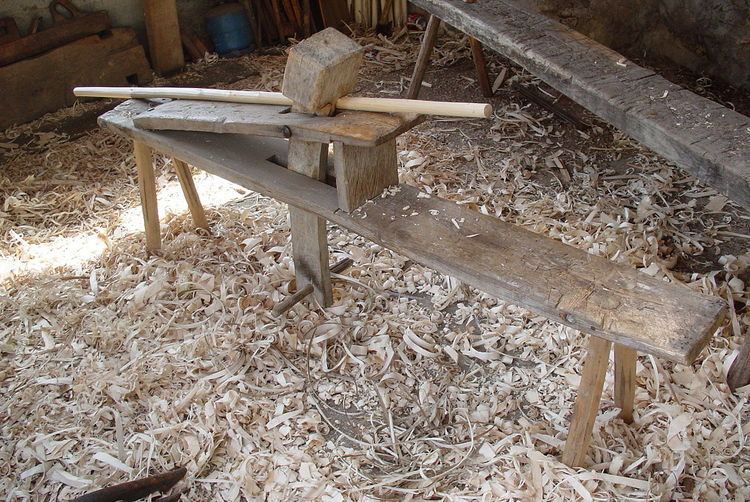 | ||
Bodging is a traditional woodturning craft, using green (unseasoned) wood to make chair legs and other cylindrical parts of chairs.
Contents
History
The term was once common around the furniture-making town of High Wycombe in Buckinghamshire, England. Bodgers were highly skilled itinerant wood-turners, who worked in the beech woods of the Chiltern Hills. The term and trade also spread to Ireland and Scotland.
The term was always confined to High Wycombe until the recent (post 1980) revival of pole lathe turning with many chairmakers around the country now calling themselves bodgers. Chairs were made and parts turned in all parts of the UK before the semi industrialised production of High Wycombe. As well recorded in Cotton the English Regional Chair
Bodgers also sold their waste product as kindling, or as exceptionally durable woven-baskets.
Chair bodgers were one of three types of craftsmen associated with the making of the traditional country "Windsor Chairs" .Of the other craftsmen, involved in the construction of a Windsor chair, one was the benchman who worked in a small town or village workshop and would produce the seats, backsplats and other sawn parts. The final craftsman involved was the framer. The framer would take the components produced by the bodger and the benchman and would assemble and finish the chair.
In the early years of the 20th century, there were about 30 chair bodgers scattered within the vicinity of the High Wycombe furniture trade. Although there was great camaraderie and kinship amongst this close community nevertheless a professional eye was kept upon what each other was doing. Most important to the bodger was which company did his competitors supply and at what price. Bodger Samuel Rockall's account book for 1908 shows he was receiving 19 shillings (228p) for a gross (144 units) of plain legs including stretchers. With three stretchers to a set of four legs this amounted to 242 turnings in total.
Another account states: "a bodger worked ten hours a day, six concurrent days a week, in all weathers, only earning thirty shillings a week" (360 pence=£1.10s.-)
The rate of production was surprisingly high. According to Ronald Goodearl, who photographed one of the last professional bodgers Alec and Owen Dean in the late 1940s, recalled they had stated "each man would turn out 144 parts per day (one gross) including legs and stretchers- this would include cutting up the green wood, and turning it into blanks, then turning it".
Etymology
The origins of the term are obscure. One theory is that bodges, defined as rough sacks of corn, closely resembled packages of finished goods the bodgers carried when they left the forest or workshop. Another theory (dating from 1879) is that bodger was a corruption of badger, as similarly to the behaviour of a badger, the bodger dwelt in the woods and seldom emerged until evenings.
Other theories about its origin include the German word Böttcher (cooper, a trade that uses similar tools), and similar Scandinavian words, such the Danish name Bødker. These words have similar origins to the English word butt, as in water butt.
Tools
The bodger's equipment was so easy to move and set up that it was easier to go to the timber and work it there than to transport it to a workshop. The completed chair legs were sold to furniture factories to be married with other chair parts made in the workshop.
Common bodger's or bodging tools included:
Accommodation
A bodger commonly camped in the open woods in a "bodger's hovel" or basic "lean-to"-type shelter constructed of forest-floor lengths suitable for use as poles lashed, likely with twine, together to form a simple triangular frame for a waterproof thatch roof. The "sides" of the shelter may have been enclosed in wicker or wattled manner to keep out driving rain, animals, etc.
High Wycombe lathe
High-Wycombe lathe became a commonly used generic term to describe any wooden-bed pole lathe, irrespective of user or location, and remained the bodger's preferred lathe until the 1960s when the trade died out, losing to the more cost-effective and rapid mechanised mass production factory methods.
Working practices
Traditionally, a bodger would buy a stand of trees from a local estate, set up a place to live (his bodger's hovel) and work close to trees.
After felling a suitable tree, the bodger would cut the tree into billets, approximately the length of a chair leg. The billet would then be split using a wedge. Using the side-axe, he would roughly shape the pieces into chair legs. The drawknife would farther refine the leg shape. The finishing stage was turning the leg with the pole lathe (the pole lathe was made on site). Once the leg or stretchers were finished, being of "green" wood, they required seasoning. Chair legs would be stored in piles until the quota (usually a gross of legs and the requisite stretchers) was complete. The bodger would then take their work to one of the large chair-making centres. The largest consumer of the day was the High Wycombe Windsor chair industry. After completion the chairs were sold on to dealers, mainly in the market town of Windsor, Berkshire, which is possibly how the name "Windsor Chair" originated.
Notable bodgers
Samuel Rockall learnt the trade from his uncle, Jimmy Rockall. At the age of 61, Samuel was almost the last of the living chair bodgers. Rockall’s bodging tradition was captured on film shortly after he died in 1962. His two sons helped in the reconstruction of his working life in the woods and his workshop. The colour film was produced by the furniture manufacturer Parker Knoll and follows the complete process using Sam’s own tools and equipment. A film copy is available at the Wycombe Museum.
